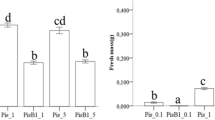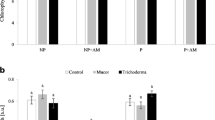Abstract
Six strains of ectomycorrhizal fungi were compared for their ability to increase zinc tolerance in Pinus sylvestris L. seedlings. Pioneer and ‘late-stage’ fungi as well as one strain collected from a Zn-polluted site were included in the study. The accumulation of zinc in the host plants was determined at two different sublethal substrate Zn concentrations. The mycobionts varied considerably in their protection of the autobionts against zinc toxicity. Several fungal species reduced zinc accumulation in the pine seedlings. A Thelephora terrestris (Ehrh.) Fr. Strain, however, increased the Zn concentration in its host plants. Specific zinc-retaining capacity of the mycelium and density of the extramatrical mycelium were important features determining the effectiveness of the zinc retention in the fungal symbiont.
The experiments were carried out in a growth chamber where plants were cultivated in root observation chambers. The determination of the extent of substrate colonization showed that an elevated zinc concentration in a substrate might be an important stress factor for the growth of an ectomycorrhizal fungus. The growth of the extramatrical mycelium of some species was inhibited at the highest zinc concentration supplied. A determination of the in vitro zinc tolerance of the fungi could not always predict their tolerance as symbionts, where the latter characteristic did not determine the Zn retention capacity of their mycelium.
In this paper we also discuss the possibility that on Zn-polluted soils ectomycorrhizal species and strains are selected that are Zn-tolerant and, in addition, are able to protect their own energy source, the autobiont, from toxicity. These mycorrhizal fungi act as a safety net, that can immobilize large amounts of zinc, thus preventing transport to the host plant.
Similar content being viewed by others
References
Balsberg Pahlsson A-M 1989 Toxicity of heavy metals (Zn, Cu, Cd, Pb) to vascular plants: A literature review. Water, Air, Soil Pollut. 47, 287–319.
Berry W L and Wallace A 1989 Zinc phytotoxicity: Physiological responses and diagnostic criteria for tissues and solutions. Soil Sci. 147, 390–397.
Bowen G D, Skinner M F and Bevege D I 1974 Zinc uptake by mycorrhizal and uninfected roots of Pinus radiata and Araucaria cunninghamii. Soil Biol. Biochem. 6, 141–144.
Bradley R, Burt A J and Read D J 1981 Mycorrhizal infection and resistance to heavy metal toxicity in Calluna vulgaris. Nature 292, 335–337.
Bradley R, Burt A J and Read D J 1982 The biology of mycorrhiza in the Ericaceae. VIII. The role of mycorrhizal infection in heavy metal resistance. New Phytol. 91, 197–209.
Brown M T and Wilkins D A 1985a Zinc tolerance in Betula. New Phytol. 99, 91–100.
Brown M T and Wilkins D A 1985b Zinc tolerance of mycorrhizal Betula. New Phytol. 99, 101–106.
Chilvers G A, Douglass P A and Lapeyrie F 1986 A paper-sandwich technique for rapid synthesis of ectomycorrhizas. New Phytol. 103, 397–402.
Colpaert J V and VanAssche J A 1987 Heavy metal tolerance in some ectomycorrhizal fungi. Funct. Ecol. 1, 415–421.
Colpaert J V, VanAssche J A and Luijtens K 1992 The growth of the extramatrical mycelium of ectomycorrhizal fungi and the growth response on Pinus sylvestris L. New Phytol. 120, 127–135.
Darlington A B and Rauser W E 1988 Cadmium alters the growth of the ectomycorrhizal fungus Paxillus involutus: A new growth model accounts for changes in branching. Can. J. Bot. 66, 225–229.
Denny H J and Wilkins D A 1987a Zinc tolerance in Betula spp. III. Variation in response to zinc among ectomycorrhizal associates. New Phytol. 106, 535–544.
Denny H J and Wilkins D A 1987b Zinc tolerance in Betula spp., IV. The mechanism of ectomycorrhizal amelioration of zinc toxicity. New Phytol. 106, 545–553.
Dixon R K and Buschena C A 1988 Response of ectomycorrhizal Pinus banksiana and Picea glauca to heavy metals in soil. Plant and Soil 105, 265–271.
Gadd G M, Mowll J L and White C 1985 Heavy metal uptake by fungi. In Proc. Int. Congress: Heavy Metals in the Environment. Ed. T D Lekkas, pp 37–39. Athens, Greece.
Gast C H, Jansen E, Bierling J and Haanstra L 1988 Heavy metals in mushrooms and their relationship with soil characteristics. Chemosphere 17, 789–799.
Ingestad T, Arveby A S and Kähr M 1986 The influence of ectomycorrhiza on nitrogen nutrition and growth of Pinus sylvestris seedlings. Physiol. Plant. 68, 575–582.
Jones M D and Hutchinson T C 1986 The effect of mycorrhizal infection on the response of Betula papyrifera to nickel and copper. New Phytol. 102, 429–442.
Jones M D and Hutchinson T C 1988a The effects of nickel and copper on the axenic growth of ectomycorrhizal fungi. Can. J. Bot. 66, 119–124.
Jones M D and Hutchinson T C 1988b Nickel toxicity in mycorrhizal birch seedlings infected with Lactarius rufus or Scleroderma flavidum. I. Effects on growth, photosynthesis, respiration and transpiration. New Phytol. 108, 451–459.
Li X-L, Marschner H and George E 1991 Acquisition of phosphorus and copper by VA-mycorrhizal hyphae and root-to-shoot transport in white clover. Plant and Soil 136, 49–57.
Nylund J-E and Wallander H 1989 Effects of ectomycorrhiza on host growth and carbon balance in a semi-hydroponic cultivation system. New Phytol. 112, 389–398.
Plassard C, Coll A, Mousain D et Salsac L 1988 Estimation quantitative de l'infection ectomycorhizienne du pin maritime Pinus pinaster Aiton en pépinière. Acta Oecol./ Oecol. Plant. 9, 381–391.
Read D J, Francis R and Finlay R D 1985 Mycorrhizal mycelia and nutrient cycling in plant communities. In Ecological Interactions in Soil. Ed. A HFitter. pp 193–217. Blackwell Scientific Publications. Oxford.
Vignon C, Plassard C, Mousain D and Salsac L 1986 Assay of fungal chitin and estimation of mycorrhizal infection. Physiol. Vég. 24, 201–207.
Wilcox H E 1968 Morphological studies of the roots of red pine, Pinus resinosa. II. Fungal colonization of roots and the development of Mycorrhizae. Am. J. Bot. 55, 686–700.
Zhu H, Higginbotham K O, Dancik B P and Navratil S 1988 Intraspecific genetic variability of isozymes in the ectomycorrhizal fungus Suillus tomentosus. Can. J. Bot. 66, 588–594.
Author information
Authors and Affiliations
Rights and permissions
About this article
Cite this article
Colpaert, J.V., Van Assche, J.A. Zinc toxicity in ectomycorrhizal Pinus sylvestris . Plant Soil 143, 201–211 (1992). https://doi.org/10.1007/BF00007874
Received:
Issue Date:
DOI: https://doi.org/10.1007/BF00007874




